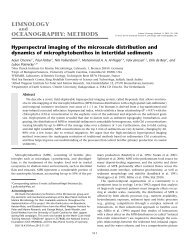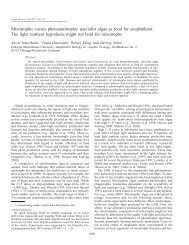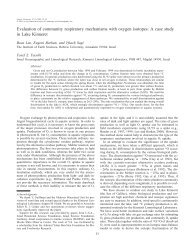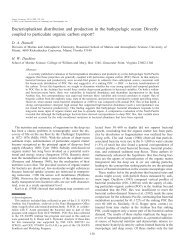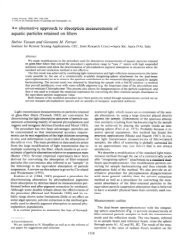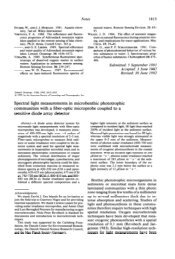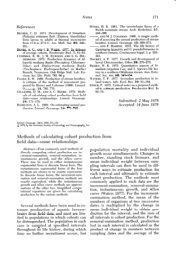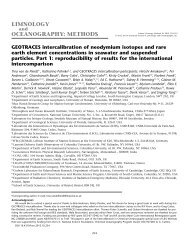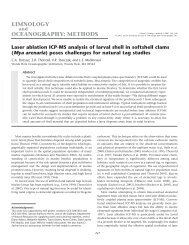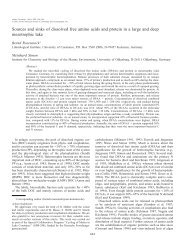Chia Yu Lin and Steven L. Manley. Bromoform production from - ASLO
Chia Yu Lin and Steven L. Manley. Bromoform production from - ASLO
Chia Yu Lin and Steven L. Manley. Bromoform production from - ASLO
You also want an ePaper? Increase the reach of your titles
YUMPU automatically turns print PDFs into web optimized ePapers that Google loves.
Workshop 3: Sustainable Manufacturing:<br />
Information Modeling for Sustainable<br />
Manufacturing St<strong>and</strong>ards, Methodologies <strong>and</strong><br />
Practices<br />
Sunday, August 28, 2011<br />
8:00am–12:00pm Location: Lexington<br />
Instructors: Sudarasan Rachuri<br />
(sudarsan.rachuri@nist.gov)<br />
Anantha Narayanan<br />
(anantha.narayanan@nist.gov)<br />
Paul Witherell (paul.witherell@nist.gov)<br />
Kevin Lyons (kevin.lyons@nist.gov)<br />
Mahesh Man i (Mahesh.mani@nist.gov)<br />
Guodong Shao (gshao@nist.gov)<br />
Overview:<br />
Sustainability is a holistic systems approach for the <strong>production</strong><br />
<strong>and</strong> consumption of goods <strong>and</strong> services that minimizes<br />
resource depletion while maximizing value to the producer,<br />
consumer, <strong>and</strong> society at large. Sustainable manufacturing<br />
takes into account various factors including: energy efficiency,<br />
resource usage, health <strong>and</strong> safety of plant workers, <strong>and</strong><br />
depending on the markets, a variety of environmental<br />
regulations. To maintain a competitive edge, manufacturers<br />
must be able to quickly assess the impacts of different design<br />
choices, <strong>and</strong> develop a good underst<strong>and</strong>ing of health, safety<br />
<strong>and</strong> environmental regulations. This calls for a systems<br />
approach that considers all aspects of the enterprise, <strong>and</strong><br />
comprehensively captures <strong>and</strong> utilizes the properties of the<br />
various interacting systems.<br />
Workshop 4: Teraflop Parallel Computing on a<br />
Budget: Applications of Graphics Processing Unit<br />
(GPU) Computing in Mechanical Engineering<br />
Sunday, August 28, 2011<br />
8:00am–5:00pm Location: Bunker Hill<br />
Instructors: Dan Negrut (negrut@engr.wisc.edu)<br />
Krishnan Suresh (suresh@engr.wisc.edu)<br />
Sara McMains (mcmains@me.berkeley.edu)<br />
Overview:<br />
As the computer microprocessor industry rallies behind a new<br />
design paradigm that emphasizes parallel architectures, today’s<br />
computational methods in Mechanical Engineering, mostly<br />
drawing on sequential computing algorithms, are gradually<br />
becoming ill-positioned to answer the ever growing modeling<br />
<strong>and</strong> simulation challenges posed by engineering applications. In<br />
this l<strong>and</strong>scape, the GPU recently emerged as a convenient <strong>and</strong><br />
inexpensive accelerator (co-processor) that can deliver today<br />
0.5 TFlops at a cost of less than $1500. Enabling speedups by<br />
factors of 10 to 100, GPU computing in particular <strong>and</strong> parallel<br />
computing in general usher in an era where each one of us will<br />
have Teraflop level computational speed at our fingerprints.<br />
50<br />
WORKSHOPS<br />
This workshop provides a GPU computing how-to tutorial that<br />
will be augmented with a h<strong>and</strong>s-on GPU programming session.<br />
The participants will have the opportunity to use their laptops to<br />
remotely log into a GPU cluster <strong>and</strong> underst<strong>and</strong> through<br />
concrete h<strong>and</strong>s-on examples some of the concepts covered in<br />
the first part of the workshop. The workshop will conclude with<br />
a discussion of optimization techniques for effective GPU<br />
computing <strong>and</strong> an overview of research that has benefited <strong>from</strong><br />
the computational power available on today’s commodity GPU<br />
cards.<br />
Please note that due to a limit of 40 GPU-cluster accounts we<br />
might not have user accounts for all workshop participants. The<br />
cluster accounts will be available on a first-come first-served<br />
basis.<br />
Workshop 5: Precision Structronic <strong>and</strong> Mechatronic<br />
Devices with Smart Materials<br />
Sunday, August 28, 2011<br />
8:00am–12:00pm Location: Congressional B<br />
Instructor: Hornsen (HS) Tzou (hstzou@zju.edu.cn)<br />
Overview:<br />
“Smart structures <strong>and</strong> structronic systems” technology has<br />
been evolving for over two decades. This tutorial focuses on the<br />
design <strong>and</strong> application aspects of the technology. Histories,<br />
fundamental characteristics, materials (e.g., piezoelectrics,<br />
electro- <strong>and</strong> magneto-strictive materials, shape memory<br />
materials, electro- <strong>and</strong> magneto-rheological fluids, photostrictive<br />
materials, polyelectrolyte gels, pyroelectric materials, magnetooptical<br />
materials, superconductors, etc.), design principles,<br />
precision devices (sensors <strong>and</strong> actuators), micro-/nanoactuations,<br />
<strong>and</strong> practical applications (<strong>from</strong> aerospace<br />
structures, mechanical systems to micro-/nano-devices) are<br />
emphasized. Modern research issues are also discussed.




